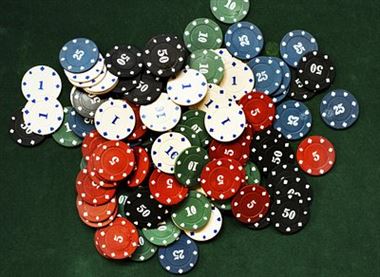Poker Mastery 101: Unleashing Advanced Strategies for Success is a comprehensive guide that delves into the intricacies of poker and provides players with advanced strategies to enhance their gameplay. This book is designed for both intermediate and experienced players who are looking to take their skills to the next level and achieve mastery in the game of poker. By exploring various advanced techniques, analyzing hand scenarios, and understanding psychological aspects of the game, this guide aims to equip players with the knowledge and tools necessary to excel at the highest levels of poker. Whether you’re a cash game player or a tournament enthusiast, Poker Mastery 101 offers valuable insights and strategies to help you maximize your success on the poker table.
Advanced Techniques for Improving Your Poker Strategy
Poker is a game of skill and strategy, and mastering it requires more than just luck. In order to truly excel at poker, players must go beyond the basics and delve into advanced techniques that can give them an edge over their opponents. This section will explore some of these advanced strategies and provide insights on how to incorporate them into your own poker game.
One of the most important aspects of advanced poker strategy is understanding the concept of pot odds. Pot odds refer to the ratio of the current size of the pot to the cost of a contemplated call. By calculating pot odds, players can determine whether or not a particular bet or call is mathematically profitable in the long run. This allows players to make more informed decisions based on the potential value of their hand relative to the cost of staying in the game.
Another key aspect of advanced poker strategy is understanding position and using it to your advantage. Position refers to where a player is seated relative to the dealer button, and it can have a significant impact on the outcome of a hand. Players in late position have the advantage of seeing how their opponents act before making their own decision, giving them valuable information that can be used to make better choices. Conversely, players in early position are at a disadvantage because they must act without knowing what their opponents will do.
Bluffing is another advanced technique that can be highly effective when used correctly. Bluffing involves making a bet or raise with a weak hand in order to deceive your opponents into thinking you have a stronger hand than you actually do. Successful bluffing requires careful observation of your opponents’ playing styles and tendencies, as well as the ability to read their body language for signs of weakness or strength. Timing is also crucial when bluffing, as a poorly timed bluff can easily be exposed by observant opponents.
In addition to these specific techniques, advanced poker strategy also involves developing a strong mental game. This includes maintaining focus and concentration, managing emotions, and staying disciplined. It’s important to remain calm and composed even in the face of adversity or bad beats, as emotional reactions can cloud judgment and lead to poor decision-making. Developing a strong mental game takes time and practice, but it can make a significant difference in your overall poker performance.
Finally, studying and analyzing your own play as well as the play of others is essential for improving your poker strategy. Keeping track of your wins and losses, reviewing hand histories, and seeking feedback from other experienced players can help identify areas for improvement and highlight any patterns or tendencies that may be exploitable by opponents. Additionally, watching professional poker players in action, either live or through recorded footage, can provide valuable insights into advanced strategies and techniques.
In conclusion, mastering advanced poker strategies is crucial for achieving success in the game. Understanding pot odds, utilizing position, bluffing effectively, developing a strong mental game, and continuously studying and analyzing your play are all key components of becoming a skilled poker player. By incorporating these advanced techniques into your own poker game, you can increase your chances of winning and take your poker skills to the next level.
Mastering Bluffing and Reading Your Opponents in Poker
Poker is a game of skill and strategy, and mastering bluffing and reading your opponents is crucial for success. Bluffing is an art form in poker, and when done correctly, it can lead to big wins. However, it requires careful observation and understanding of your opponents’ behavior.
Firstly, let’s delve into the concept of bluffing. Bluffing involves making your opponents believe that you have a stronger hand than you actually do. This can be achieved through various techniques such as betting aggressively or displaying confidence. Bluffing is particularly effective when playing against cautious opponents who are more likely to fold if they suspect weakness.
To successfully bluff, you must pay close attention to your opponents’ actions and reactions. Look for signs of discomfort, hesitation, or inconsistency in their betting patterns. These could indicate that they are unsure about the strength of their own hands. Additionally, observe their body language for any subtle cues that might reveal their true intentions.
Reading your opponents is not limited to observing their physical behavior. It also involves analyzing their betting patterns and tendencies. Some players may consistently bet high with strong hands while others may only raise when they have a weak hand but want to appear strong. By paying attention to these patterns, you can gain valuable insight into the type of hands your opponents are likely to hold.
Furthermore, it is important to consider the context of the game when trying to read your opponents. Factors such as the size of the pot, the stage of the game, and the players’ chip stacks can all influence their decision-making process. For example, a player who is short-stacked and desperate to stay in the game may be more inclined to take risks and bluff more frequently.
In addition to reading your opponents, it is equally important to control your own behavior at the poker table. Avoid giving away any information through your actions or expressions. Maintain a consistent demeanor regardless of whether you have a strong hand or are bluffing. This will make it harder for your opponents to decipher your intentions and exploit any weaknesses.
Another advanced strategy in poker is the concept of reverse tells. Reverse tells involve intentionally displaying behavior that misleads your opponents. For example, you may act nervous when you have a strong hand to make your opponents believe that you are bluffing. However, this technique should be used sparingly and only against experienced players who are capable of recognizing and exploiting reverse tells.
To master bluffing and reading your opponents, practice is key. Play as many hands as possible and focus on honing your observation skills. Pay attention to the small details and learn from every encounter. Additionally, studying poker literature and watching professional players can provide valuable insights into advanced strategies and techniques.
In conclusion, mastering bluffing and reading your opponents is an essential skill in poker. Bluffing requires careful observation and understanding of your opponents’ behavior, while reading your opponents involves analyzing their actions, betting patterns, and tendencies. By combining these skills with controlled behavior and strategic thinking, you can become a formidable player at the poker table. Remember, practice makes perfect, so keep refining your skills and always be ready to adapt to different playing styles.
Understanding Pot Odds and Calculating Expected Value in Poker
Poker is a game that combines skill, strategy, and a little bit of luck. While beginners may be content with relying on their intuition or gut feeling, advanced players understand the importance of understanding pot odds and calculating expected value in order to make informed decisions and increase their chances of success.
Pot odds refer to the ratio between the current size of the pot and the cost of a contemplated call. By comparing this ratio to the probability of winning a hand, players can determine whether it is mathematically profitable to make a call or not. Calculating pot odds requires a basic understanding of probability and some simple math skills.
To calculate pot odds, start by determining the size of the pot. This includes all bets made by players before you, as well as any bets you are considering making. Next, consider the cost of your contemplated call. This could be the amount of a bet from another player or the amount needed to complete a bet yourself. Divide the cost of your call by the total size of the pot, and you will get your pot odds.
For example, if the pot is $100 and it costs you $20 to call, your pot odds would be 5:1 (100/20). This means that for every dollar you invest, you stand to win five dollars. If the probability of winning the hand is higher than 20%, it would be a profitable call in the long run.
Calculating expected value (EV) goes hand in hand with pot odds. Expected value takes into account both the potential gains and losses associated with a particular decision. To calculate EV, multiply the probability of winning a hand by the amount you stand to win and subtract the probability of losing multiplied by the amount you stand to lose.
Let’s say there is $200 in the pot, and your opponent bets $50. You estimate that you have a 25% chance of winning the hand. If you call, you stand to win the $200 pot. The EV of calling in this situation would be calculated as follows: (0.25 * $200) – (0.75 * $50) = $50 – $37.5 = $12.5.
A positive EV indicates a profitable decision, while a negative EV suggests that it is not worth making the call. By consistently making decisions with a positive expected value, players can maximize their long-term profits and improve their overall success rate.
It’s important to note that pot odds and expected value are just tools to help guide decision-making in poker. They are not foolproof guarantees of success, as luck still plays a significant role in the outcome of each hand. However, understanding these concepts and incorporating them into your strategy will undoubtedly give you an edge over less knowledgeable opponents.
In conclusion, mastering pot odds and calculating expected value is a crucial step towards becoming a successful poker player. These skills allow players to make informed decisions based on mathematical probabilities rather than relying solely on intuition. By consistently analyzing pot odds and expected value, advanced players can increase their profitability and gain an advantage at the poker table. So next time you sit down for a game, remember to consider the numbers and let them guide you towards victory.
Effective Bankroll Management Strategies for Poker Players
Poker is a game of skill and strategy, requiring players to make calculated decisions in order to win. However, even the most skilled players can find themselves on a losing streak if they fail to manage their bankroll effectively. Bankroll management is an essential aspect of poker mastery, as it ensures that players have enough funds to weather the ups and downs of the game.
One key strategy for effective bankroll management is setting aside a dedicated poker bankroll. This means separating your poker funds from your personal finances, ensuring that you only play with money you can afford to lose. By having a separate bankroll, you can avoid dipping into your personal savings or going into debt to fund your poker games.
Another important aspect of bankroll management is determining how much of your bankroll to risk on each game. A common rule of thumb is to never risk more than 5% of your total bankroll on any single game. This conservative approach helps to minimize losses and protect your bankroll from significant swings. By adhering to this guideline, you can ensure that you have enough funds to continue playing even if you encounter a string of bad luck.
In addition to setting limits on individual games, it’s also crucial to establish overall bankroll goals. This involves determining what percentage of your bankroll you aim to increase or decrease by over a specific period of time. For example, you may set a goal of increasing your bankroll by 10% per month. By having clear goals, you can track your progress and evaluate whether your strategies are working effectively.
To further safeguard your bankroll, it’s advisable to implement stop-loss limits. These limits define the maximum amount you are willing to lose in a single session or day. If you reach your stop-loss limit, it’s important to have the discipline to walk away and take a break. Emotions can run high during poker games, and it’s easy to get caught up in the desire to recoup losses. However, by sticking to your predetermined limits, you can prevent yourself from making impulsive decisions that could further deplete your bankroll.
Another useful strategy for managing your bankroll is to practice proper game selection. Not all poker games are created equal, and some may have higher stakes or tougher opponents than others. By carefully selecting the games you participate in, you can maximize your chances of winning and minimize your risk of losing. It’s important to assess your skill level honestly and choose games that align with your abilities. Playing against weaker opponents can be more profitable in the long run, as it increases your chances of coming out ahead.
Lastly, it’s crucial to regularly review and evaluate your bankroll management strategies. As you gain experience and improve your skills, you may need to adjust your approach accordingly. Additionally, monitoring your progress allows you to identify any patterns or trends that may impact your bankroll. By staying vigilant and adaptable, you can continuously refine your bankroll management techniques and increase your chances of long-term success in the world of poker.
In conclusion, effective bankroll management is a critical component of poker mastery. By separating your poker funds from personal finances, setting limits on individual games, establishing overall bankroll goals, implementing stop-loss limits, practicing proper game selection, and regularly evaluating your strategies, you can ensure that you have the necessary funds to navigate the highs and lows of the game. With sound bankroll management in place, you’ll be well-positioned to unleash advanced strategies and achieve success at the poker table.
Analyzing Hand Histories and Using Data to Enhance Your Poker Skills
Poker is a game of skill and strategy, requiring players to make calculated decisions based on the information available. While beginners may rely on intuition and luck, advanced players understand the importance of analyzing hand histories and using data to enhance their poker skills. In this article, we will explore how studying past hands can provide valuable insights, as well as how leveraging data can give you an edge at the poker table.
Analyzing hand histories is a crucial aspect of poker mastery. By reviewing your previous hands, you can identify patterns in your own play and recognize any weaknesses or areas for improvement. This process allows you to learn from your mistakes and make adjustments to your strategy accordingly. Additionally, examining hand histories can help you gain a deeper understanding of your opponents’ tendencies, allowing you to exploit their weaknesses and maximize your profits.
One effective method of analyzing hand histories is to categorize them by different stages of the game, such as pre-flop, flop, turn, and river. By doing so, you can evaluate your decision-making process at each stage and determine if there were alternative actions that could have been more profitable. For example, you might discover that you tend to overvalue certain hands pre-flop, leading to unnecessary losses. By recognizing this pattern, you can adjust your starting hand selection and avoid costly mistakes in the future.
Furthermore, utilizing software tools specifically designed for tracking and analyzing hand histories can greatly enhance your poker skills. These programs allow you to review your own performance statistics, such as your win rate, average pot size, and aggression factor. They also enable you to analyze specific situations, such as how often you fold to continuation bets or how frequently you bluff on the river. Armed with this information, you can fine-tune your strategy and exploit your opponents’ tendencies more effectively.
In addition to analyzing hand histories, incorporating data into your poker strategy is essential for success. Data-driven decision making enables you to make informed choices based on statistical probabilities rather than relying solely on intuition. For instance, understanding the concept of pot odds can help you determine whether a particular bet is mathematically profitable in the long run. By calculating the ratio between the current size of the pot and the cost of a potential call, you can make more rational decisions that align with your overall strategy.
Moreover, utilizing data to identify player types and their corresponding playing styles can give you a significant advantage. By observing how your opponents behave in different situations, you can classify them as tight or loose, aggressive or passive. This knowledge allows you to adjust your own strategy accordingly and exploit their weaknesses. For example, if you notice that a player frequently folds to aggression, you can increase your bluffing frequency against them and steal pots uncontested.
In conclusion, analyzing hand histories and incorporating data into your poker strategy are essential components of achieving mastery in this game. By studying past hands, you can learn from your mistakes, identify patterns, and improve your decision-making process. Additionally, leveraging data through software tools and statistical analysis provides valuable insights into your own performance and your opponents’ tendencies. With these advanced strategies at your disposal, you can elevate your poker skills to new heights and increase your chances of success at the table.




